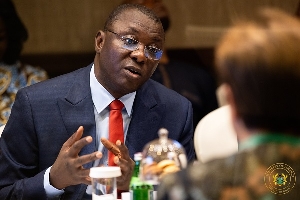
Finance Minister, Dr. Mohammed Amin Adam has disclosed that government of Ghana has finalized a deal with Independent Power Producers (IPPs) to restructure arrears following six years of negotiations.
According to the Finance Minister, the agreement includes the IPPs accepting a reduction in their claims (haircut), allowing the government to spread payment over a five year period.
“The negotiations have been going on for six years, and I am happy to announce that last week, l closed the negotiations with the IPPs,” he revealed.
The Minister stressed that the deal, which has been closed with some four IPPs, has yielded significant fiscal relief.
“We have closed it, and we have restructured the arrears of the independent power producers in Ghana, particularly the four major independent power producers in Ghana, [in a way] that has brought us some significant haircut or discount and that now allows us to spread the balance over five years or above.”
Dr. Amin Adam also said that “the problem that Ghana’s energy sector is faced with is now under control. The ECG [Electricity Company of Ghana] managing director is here, and he will confirm that we will stop interruption in power supply in order to provide reliable power for industry to thrive, so we can support the growth efforts of our economy.”
Ghana’s energy sector
Ghana’s energy sector is a debt making-machine, accumulating approximately $1 billion in debt annually, with around $500 million stemming from excess capacity charges.
According to a 2023 IMF assessment of Ghana’s energy sector, the West African nation has “almost doubled electricity tariffs over the past year to bring them close to the cost recovery level, but distribution and commercial losses persist.”
In fact, below-cost-recovery tariffs (usually as a result of exchange rate fluctuations), distribution and recovery losses, and excess capacity combined with take-or-pay contracts have led to large financial shortfalls over the past few years. By end-2022, the IMF estimated Ghana’s outstanding energy sector debt had reached $1.6 billion owed mainly to IPPs and fuel suppliers, and was nearing $2 billion.
In IMF’s assessment, “the government continued to accumulate payables during the first half of [2023], hence breaching the related program indicative target”. It stressed that non-energy sector payables declined, but energy sector payables increased due to low recoveries in the sector, tight financing conditions, and pending negotiations with Independent Power Producers (IPPs).
During foreign exchange crises, the energy sector faces challenges due to the majority of power generation costs being in dollars while revenue is primarily in cedis, resulting in significant exchange losses during debt settlements.
According to the World Bank, Ghana incurs losses of over $680 million yearly due to load shedding or power outages. The Electricity Company of Ghana (ECG) recently disclosed that it issued over 100 power outage notifications in the first two and a half months of this year, primarily due to maintenance activities.
Ghana’s current peak demand has surged to 3,618 MW, significantly exceeding the available capacity of 3,251 MW. With an installed capacity of 5,626 MW, the nation is only utilizing approximately 58% of its total capacity, leaving a considerable deficit of 2,375 MW. This deficit is compounded by a 740 MW shortfall attributed to ongoing maintenance, further straining the electricity supply infrastructure.
Among the maintenance-related issues, 330 MW remains uncertain in terms of restoration timelines, adding complexity to the grid’s stability. Additionally, 4 thermal plants, collectively capable of generating 595 MW, are offline due to inadequate fuel supply, while a fault in the TICO unit 3 plant has rendered 120 MW unavailable until December 2024, impacting the entire year’s power generation by that capacity.
Consequently, Ghana faces a significant 1,455 MW shortfall in electricity generation capability, with gas supply limitations exacerbating the challenge. Despite efforts to reduce power exports by 40% during peak hours to prioritise local demand, the gap persists!
In December 2023, the Ghana Energy Commission warned of potential power outages due to fuel supply restrictions and planned maintenance issues, which could lead to a significant loss of dependable capacity in the country. The Commission estimated that Ghana would need to spend around $1.2 billion to purchase fuel for its predominantly thermal power plants, which contribute over 65% of the nation’s dependable capacity.
Ghana traditionally relied on the West African Gas Pipeline (WAPCo) network to import fuel from Nigeria for its power plants. However, recent foreign exchange challenges and Ghana’s inability to meet its debt obligations forced WAPCo to halt fuel supply to Ghana at the beginning of the year.
The Energy Ministry revealed that Ghana owed WAPCo approximately $19 million, and a payment of $10 million was required upfront to resume services. Despite this payment, Ghana has accumulated another debt, leading WAPCo to hesitate in continuing business relations with the country.
The hydroelectric landscape presents mixed outcomes, with the Akosombo dam maintaining a stable electricity generation due to its sufficient water levels, while the Bui dam’s declining levels raise concerns. If the downward trend persists, the Bui dam’s ability to generate power could be compromised, leading to its restricted usage to peak hours only.
To align generation capabilities with demand, Ghana resorted to implement power shedding measures, shedding 380 MW during normal times and an additional 505 MW during peak hours daily. The primary challenge remains the inadequate gas supply. Meanwhile, utilising idle thermal plants can partially offset the 505 MW shortfall during peak times caused by fuel shortages or equipment faults.




